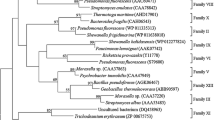Abstract
Using a metagenome library constructed from a bacterial associated with a marine sponge Hyrtios erecta, we identified a novel esterase that belongs to the SGNH hydrolase superfamily of esterases. The substrate specificity of EstHE1 was determined using p-nitrophenyl (pNP) ester (C2: acetate, C4: butylate, C6: caproate, C12: laurate, C16: palmitate). EstHE1 exhibited activity against C2 (5.6 U/mg), C4 (5.1 U/mg), and C6 (2.8 U/mg) substrates. The optimal temperature for EstHE1 esterase activity of the pNP acetate substrate was 40°C, and EstHE1 retained 60% of its enzymatic activity in the 30–50°C range. This esterase showed moderate thermostability, retaining 58% of its activity even after preincubation for 12 h at 40°C. EstHE1 also maintained activity in high concentrations of NaCl, indicating that this esterase is salt-tolerant. Thus, EstHE1 has the thermal stability and salt tolerance necessary for use as an industrial enzyme.







Similar content being viewed by others
References
Akoh CC, Lee GC, Liaw YC, Huang TH, Shaw JF (2004) GDSL family of serine esterases/lipases. Prog Lipid Res 43:534–552
Baker EN (1980) Structure of actinidain, after refinement at 1.7 Å resolution. J Mol Biol 141:441–484
Cherry JR, Fidantsef AL (2003) Directed evolution of industrial enzymes: an update. Curr Opin Biotechnol 14:438–443
Cho H, Cronan JE Jr (1993) Escherichia coli thioesterase I, molecular cloning and sequencing of the structural gene and identification as a periplasmic enzume. J Biol Chem 268:9238–9245
Dalrymple BP, Cybinski DH, Layton I, McSweeney CS, Xue GP, Swading YJ, Lowry JB (1997) Three Neocallimastix patriciarum esterases associated with the degradation of complex polysaccharides are members of a new family of hydrolases. Microbiology 143:2605–2614
Fukuda T, Kato-Murai M, Kadonosono T, Sahara H, Hata Y, Suye S, Ueda M (2007) Enhancement of substrate recognition ability by combinatorial mutation of β-glucosidase displayed on the yeast cell surface. Appl Microbiol Biotechnol 76:1027–1033
Gibbs MD, Nevalainen KM, Bergquist PL (2001) Degenerate oligonucleotide gene shuffling (DOGS): a method for enhancing the frequency of recombination with family shuffling. Gene 271:13–20
Giovannoni SJ, Britschgi TB, Moyer CL, Field KG (1990) Genetic diversity in Sargasso Sea bacterioplankton. Nature 345:60–63
Hashida M, Bisgaard-Frantzen H (2000) Protein engineering of new industrial amylases. Trends Glycosci Glycotechnol 12:389–401
Hentschel U, Schmid M, Wagner M, Fieseler L, Gernert C, Hacker J (2001) Isolation and phylogenetic analysis of bacteria with antimicrobial activities from the Mediterranean sponges Aplysina aerophoba and Aplysina cavernicola. FEMS Microbiol Ecol 35:305–312
Huang YT, Liaw YC, Gorbatyuk VK, Huang TH (2001) Backbone dynamics of Escherichia coli thioesterase/protease I: evidence of a flexible active-site environment for a serine protease. J Mol Biol 307:1075–1090
Koshland DE (1958) Application of a theory of enzyme specificity to protein synthesis (in Symposium on Amino Acid Activation). Proc Natl Acad Sci USA 44:98–104
Li J, Derewenda U, Dauter Z, Smith S, Derewenda ZS (2000) Crystal structure of the Escherichia coli esterase II, a homolog of the human Nef binding enzyme. Nat Struct Biol 7:555–559
Lo YC, Lin SC, Shaw JF, Liaw YC (2003) Crystal structure of the Escherichia coli thioesterase I/protease I/lysophospholipase L1: consensus sequence blocks constitute the catalytic center of SGNH-hydrolases through a conserved hydrogen bond network. J Mol Biol 330:539–551
McGinnis S, Madden TL (2004) BLAST: at the core of a powerful and diverse set of sequence analysis tools. Nucleic Acids Res 1:32 (Web Server issue ): W20-5
Molgaard A, Kauppinen S, Larsen S (2000) Rhamnogalacturonan acetylesterase elucidated the structure and function of a new family of hydrolases. Struct Fold Des 8:373–383
Morimoto K, Furuta E, Hashimoto H, Inouye K (2006) Effects of high concentration of salts on the esterase activity and structure of a kiwifruit peptidase, actinidain. J Biochem 139:1065–1071
Reiswig HM (1974) Water transport, respiration and energetics of three tropical marine sponges. J Exp Mar Biol Ecol 14:231–249
Rondon MR, August PR, Bettermann AD, Brady SF, Grossman TH, Liles MR, Loiacono KA, Lynch BA, MacNeil IA, Minor C, Tiong CL, Gilman M, Osburne MS, Clardy J, Handelsman J, Goodman RM (2000) Cloning the soil metagenome: a strategy for accessing the genetic and functional diversity of uncultured microorganisms. Appl Environ Microbiol 66:2541–2547
Thompson JD, Higgins DG, Gibson TJ (1994) CLUSTAL W: Improving the sensitivity of progressive multiple sequence alignment through sequence weighting, position specific gap penalties and weight matrix choice. Nucleic Acids Res 22:4673–4680
Upton C, Buckley JT (1995) A new family of lipolytic enzymes? Trends Biochem Sci 20:178–179
Vacelet J, Donadey C (1977) Electron microscope study of the association between some sponges and bacteria. J Exp Mar Biol Ecol 30:301–314
Watanabe S, Saleh AA, Pack SP, Annaluru N, Kodaki T, Makino K (2007) Ethanol production from xylose by recombinant Saccharomyces cerevisiae expressing protein-engineered NADH-preferring xylose reductase from Pichia stipitis. Microbiol 153:3044–3054
Webster NS, Wilson KJ, Blackall LL, Hill RT (2001) Phylogenetic diversity of bacteria associated with the marine sponge Rhopaloeides odorabile. Appl Environ Microbiol 67:434–444
Yokouchi H, Fukuoka Y, Mukoyama D, Calugay R, Takeyama H, Matsunaga T (2006) Whole-Metagenome Amplification of a Microbial Community Associated with Scleractinian Coral by Multiple Displacement Amplification Using ϕ29 Polymerase. Environ Microbiol 8:1155–1163
Acknowledgment
This work was funded in part by the New Energy and Industrial Technology Development Organization (NEDO) as part of a research and development project of the Industrial Science and Technology Frontier Program.
Author information
Authors and Affiliations
Corresponding author
Rights and permissions
About this article
Cite this article
Okamura, Y., Kimura, T., Yokouchi, H. et al. Isolation and Characterization of a GDSL Esterase from the Metagenome of a Marine Sponge-associated Bacteria. Mar Biotechnol 12, 395–402 (2010). https://doi.org/10.1007/s10126-009-9226-x
Received:
Accepted:
Published:
Issue Date:
DOI: https://doi.org/10.1007/s10126-009-9226-x




